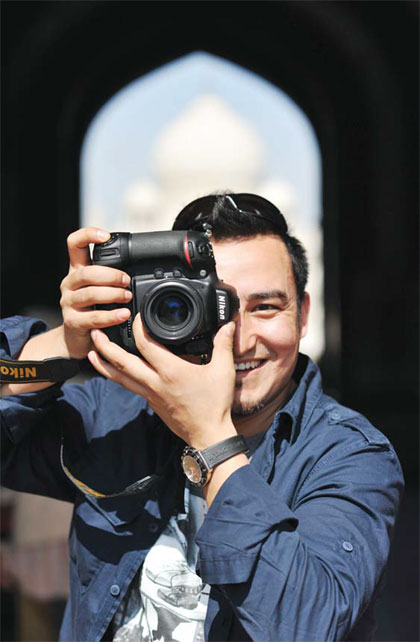Fighting stereotypes
Updated: 2015-09-25 08:03
By Cheng Lu and Wen Chihua(China Daily Europe)
|
|||||||||||
 |
|
Kurbanjan Samat works on his project of photographing 120 Xinjiang people who live elsewhere in the country and getting their stories. Xiao Wei / For China Daily |
Samat decided then to let his lens do his fighting: "Pictures and real stories are the most eloquent way to talk about Xinjiang."
The terrorist attack at Kunming Railway Station in March last year increased his resolve. He traveled to 20 cities to photograph and interview about 500 Xinjiang people including doctors, celebrities, street vendors and thieves.
In one of the more striking stories, a Uygur thief told him how, at age 9, he was sold by his father to a modern-day "Fagin" in the southern city of Guangzhou. His owner beat him on one occasion after he took pity on a female victim and gave her back the money he had stolen from her.
"I'm trying to make my photo essay objective, covering different Xinjiang people and their stories," Samat explains. "We're all Chinese no matter where we are from - Xinjiang, Beijing or Guangdong."
He says he finds misconceptions of Xinjiang and China in all parts of the world. Last year, he visited the Indonesian island of Bali and a customs officer at the airport questioned his Chinese identity based on his Uygur appearance.
"The officer thought I was from Turkey, India, Iran or even Mexico, but not China," he recalls. "I can't speak English. The officer tried to speak Chinese, but it was very broken and I couldn't understand him, which he took as evidence I wasn't Chinese."
Fortunately, a Chinese tourist behind Samat in the line was irritated. "He told the officer that China has 56 ethnic groups with diverse cultures. No single group alone can represent China."
It is this kind of misunderstanding that has encouraged Samat to accept invitations from overseas Chinese students and academics to give lectures at universities in the United States, starting at Harvard.
The title of his speech - Promoting Exchange with Love: I Am from Xinjiang - references the first Chinese character he learned to write at school, "love".
The principle of love and its usefulness in countering xenophobia stands in contrast to other things Samat remembers learning about Xinjiang at school. He believes Chinese education puts too much emphasis on the differences between ethnic groups.
One textbook given to him as a child stereotyped Han people as characters wearing white towels tied around their heads and a drum on their waists, and Uygurs as dancers with flowery hats.
Samat says he has never seen any of his Han friends don a white towel. His Uygur pal Perhat Halik, a Chinese celebrity who came second last year in TV talent show Voice of China, is not good at dancing.
He talks in a roundabout way when asked why he thinks he has found success among the many professionals to have shot photos and film about Xinjiang. Some would say his own ethnic identity makes him stand out, but Samat argues: "I don't represent any group or region. I represent myself."
One user of Douban, the online social network, points out that Samat ostensibly sets out to dispense with cultural labels but relies on his own ethnicity and the racial controversy around his subject matter for success.
The former boxer accepts some of this criticism. "When I take pictures and shoot films, I'm trying to make myself better and understand the real nature of human beings," he says.
Today's Top News
Opinion: Opportunity knocks for EU and China over next five years
Yuan rises for 7th day in a row, highest level since August
Reforms spark legal brain drain
EU officials postpone visit to Turkey after attacks in Ankara
Documents of Nanjing Massacre inscribed on Memory of World Register
Xi congratulates Kim on WPK anniversary
CPC expels media exec over UK 'green card'
Chinese students' print-like English handwriting stirs controversy
Hot Topics
Lunar probe , China growth forecasts, Emission rules get tougher, China seen through 'colored lens', International board,
Editor's Picks

|

|

|

|

|

|






